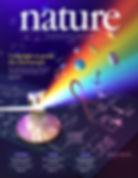Using light to probe the microscopic world
Mock editorial cover for Nature Magazine
Overview
This animated journal cover was completed as part of an Autodesk Maya Modelling and Animation course at BMC with Professor M. Dryer. My aim was to create an editorialized mock cover for a scientific magazine. Inspired by the recent Nobel Prize in Physics 2018 winners, I designed, modelled, and animated a cover for Nature Magazine celebrating the winners' research.
Date: Winter 2018
Format: Print / Digital
Skills: 3D modelling & animation
Tools: Autodesk Maya, Molecular Maya, Adobe Photoshop, Illustrator, After Effects.

Design Challenge
Create a 3D editorial magazine cover that is visually intriguing, dynamic, and captures the spirit of an interesting current scientific topic.
Target audience: readers of scientific magazines such as Nature, Scientific American, or Science.
Conception
I thought about the medium (3D) and audience prior to selecting a scientific topic and sketching proposals. I wanted my concept to translate well into 3D; a strong piece would be one where rendering it in 3D would have a clear benefit over 2D execution. I created a mood board of strong 3D work, and distilled some themes that would guide my ideation:

I thought about what made these (and other past) 3D works great, and came up with three guidelines to frame my designs proposals around:
-
The scene should allow me to use of meaningful depth of field to create atmospheric perspective and focus my subject meaningfully.
-
The scene should contain a strong main character(s) that, when rendered in 3D, benefit from the realism and are more dynamic than a 2D rendition.
-
The scene should have unique and/or atmospheric lighting, ideally with vibrant colours and/or textures that would be difficult to capture in 2D.
With these guidelines in mind, I scoured the scientific news and did a ton of thumbnailing and rough concept sketches (based on various interesting scientific topics). A few examples below:

Some of the pictured concepts (above) included the topics:
"Scientists find genetic switches for cell reprogramming" - sketches 4-6
"Do axolotls hold the secret to limb regrowth?" - sketch 3
"Physics Nobel winners use light to manipulate the microscopic" - sketches 9-12
Final comprehensive sketches
I chose a handful of my favourite thumbnails and developed more refined versions of them. My final comprehensive sketches that I pitched for feedback are shown below:

Topics depicted
1. Scientists target genes for cell reprogramming.
2. Scientists create new life without using sex cells.
3. Do axolotls hold the secret to limb regrowth?
4. Nobel prize winners in physics use light to probe the microscopic world.
With feedback from my peers and Professor Dryer, I decided to go with proposal four for the final 3D piece for several reasons. It had strong composition and was visually dynamic. Interesting information was located in "hot spots" (rule of thirds); the strong diagonal colours draw your eye to the more detailed characters within the light. There would also be great opportunity to play with depth of field, texture, and colour. Additionally, the visual metaphor of using light to "reveal" the microscopic world was communicated clearly. You can actually see how close my initial proposal resembled my final product in this case.
Final product
On the left is the first render. I later revisited the project and made some adjustments to the lighting/camera placement in order to make the colours more visually dynamic and accommodate layout changes (right).


